Blog
-
Lundy Island
First published in September 2010
I took a day trip to Lundy – a small island in the Bristol channel.I had been intrigued by the “island in the distance” for many years. On a clear day in South Gower you can just about make out the shape of an island to the right of where the Devon coastline draws out into the distance.
I was presented with the idea of visiting when I noticed an advert in the South Wales Evening Post (Swansea’s main newspaper) for day cruises to Ilfracombe and Lundy from Swansea. I decided after reading the ad that I wanted to go so I booked two tickets for a day trip in early September. Tickets were priced at £39.95 each which, for a day trip I thought was good value.
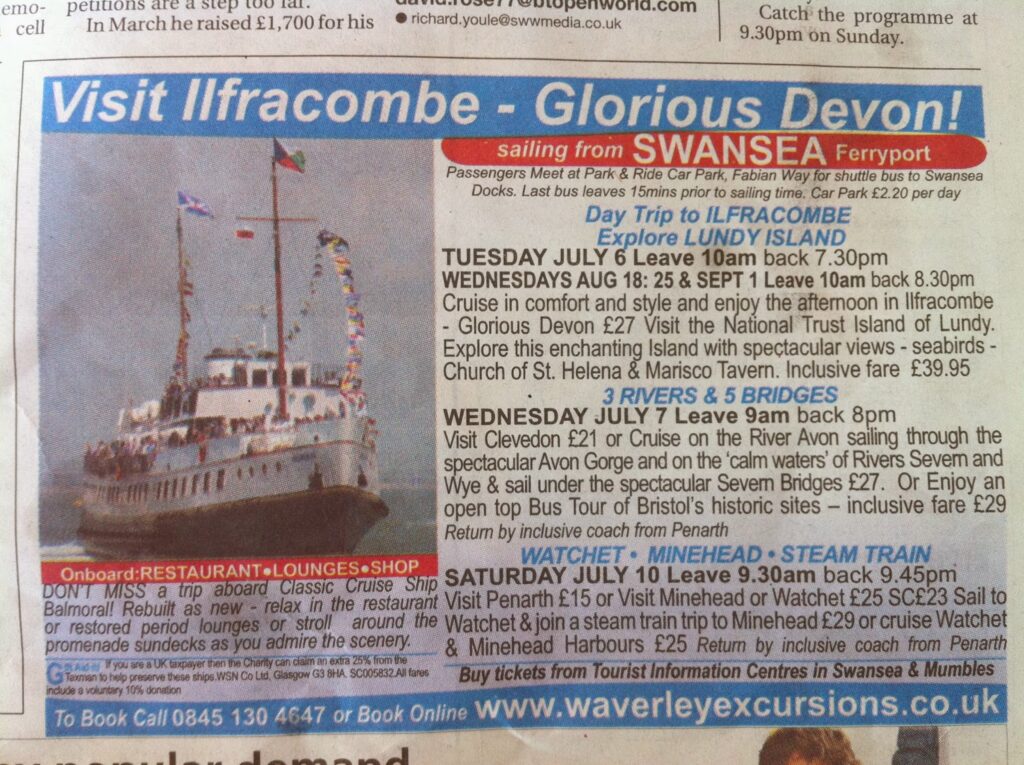
Waverley excursions advert in the South Wales Evening Post, 26th of June 2010 On the day of sailing we woke early to get to the docks. The departure time was 10am so we left Gower just before 9. The weather was forecast to be sunny and it proved to be right.
We parked at the Fabian way park and ride where we caught a shuttle bus taking passengers to Swansea docks. One memorable quote was said at this point from the marshal at the car park gate.
When asked how to get to the boat the man replied “They busin’ them in they are”.
We often find humour in South Wales mannerisms and phrases. The film Twin Town is host to many memorable Swansea catchphrases; it’s worth checking out.
We were sailing on a small cruise ship called Balmoral. A classic looking boat built in 1949 with a passenger capacity of 800. With all passengers from Swansea and Ilfracombe on board, I’d say that number was more like 200-300. Passengers boarding at Swansea probably accounted for just over half of that.
Balmoral departed Swansea on time and made its way out of Swansea Bay past Mumbles head, on a route that would take us to Ilfracombe where we would pick up more passengers before heading to Lundy.
The sea was calm throughout the journey with hardly any wind. The sun was out; the conditions couldn’t have been better.

Balmoral departing Swansea Upon arrival at Ilfracombe, we were greeted by a small crowd and the town crier. The crier took pleasure in welcoming people arriving to Ilfracombe and wishing us a safe and enjoyable trip to Lundy. It was a friendly, traditional affair and one that the passengers enjoyed. I thought it was a nice touch by Ilfracombe.

Arriving at Ilfracombe Arriving at Ilfracombe. The Town Crier and a queue of passengers awaited us.
Departing Ilfracombe, we made our way to Lundy.
After half an hour or so Lundy was coming into sight; The excitement was building as we approached the main attraction.

Approaching Lundy 
Lundy in view As we edged closer to the island we were made aware by the crew that there may be a chance the boat would not be docking. This was because the waves around the island became choppy and it would be difficult task. I still harboured hope and thankfully the boat docked at the jetty.
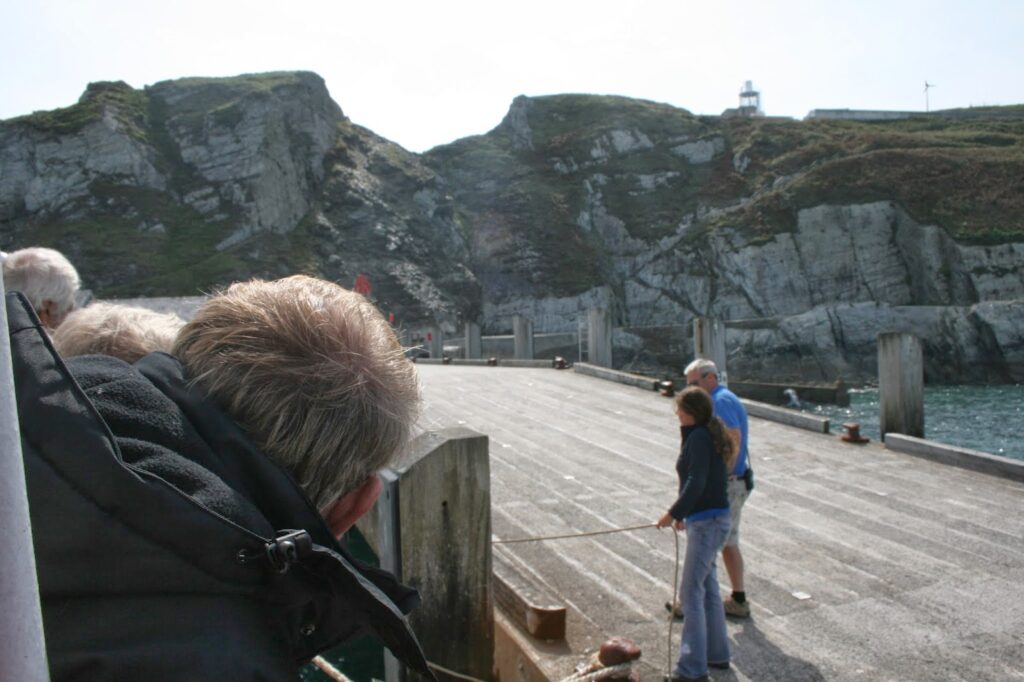
Arriving at Lundy Getting on to the island is not easy as you’d think..
Docking on Lundy took only 10-15 minutes. All the passengers watched from the sides, eager to see it happen. We disembarked and made our way from the jetty towards the top of the island. There is a long and winding pathway leading from the jetty up towards Lundy’s elevated summit.
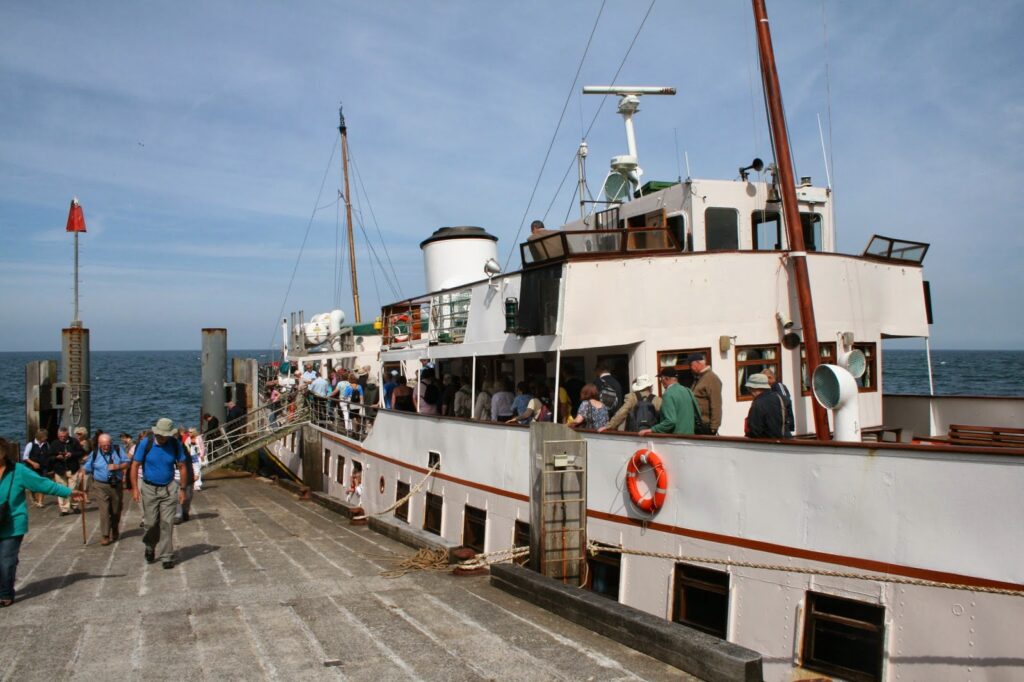
Disembarking Along the path are a couple of notable landmarks; First is what’s known as the “boat shed” – an information centre for visitors of sorts. In the shed you can read about the different wildlife on and around the island with a black board notice displaying recent sightings such as dolphins, goats, rabbits and basking sharks.

Boat shed The second notable landmark is an engraved stone with the words:
T : H
Landing
Place
1819

Landing Place Marker TH is an acronym for Trinity House, a royal charter group responsible for lighthouses around the British Isles. They proposed and built the first lighthouse on the island back in 1819. The lighthouse in question (referred to as the “Old Lighthouse”) is located on the north tip of the island on what is know as Chapel Hill. You can understand why a lighthouse was needed on the island as the Bristol channel was (and still is) a busy stretch of water with one of the strongest tidal ranges on the planet. I can imagine many vessels have come into difficulty around Lundy as it’s a small island with a rugged coastline.
Nearing the top, we encountered an elegant looking building overlooking the bay. The building is Millcombe House. It was built in 1835 for the Heaven family who had purchased the island. Conveniently positioned with what must be a fantastic view of the port; it is apparent that the family had taste! This is one of my favourite looking buildings.

Millcombe House 
Millcombe House and Balmoral The elevation around Millcombe House plateaued off slightly; we were approaching the top of the island and flatter ground. Continuing the walk, a sense of a community became more apparent as we saw a church, buildings, and what looked like a farm. I knew the island was desolate but you really got a sense of just how remote the island is when you experience the communal areas of the island. Places which if they were on the mainland would be sandwiched between buildings and busy roads. There are no public highways on the island. Roads made from gravel for the odd 4×4 or tractor but no cars. I think that’s great.

St Helena’s Church You get a sense of remoteness when you look at the church, St Helena’s. It stands on it’s own in the middle of a field. Those fields are surrounded by more fields and well, you get the idea. It looks lonely but that’s ok on this island. Saint Helena’s is not an ancient building like many others around the UK. Built in 1896 it is the same age as my great grand parents. Not much past living memory.
I appreciate churches and their architecture. This church is in excellent condition. But that’s to be expected due to its remoteness. Looking inside you can see how well looked after it is but perhaps because there are no weekly services (no priest lives on the island) – may be a better explanation.
From the church, we followed the path through what looked like the main part of a village. It certainly looked the most habitable part of the island with the gravelled road running between buildings on either side, much like a street.
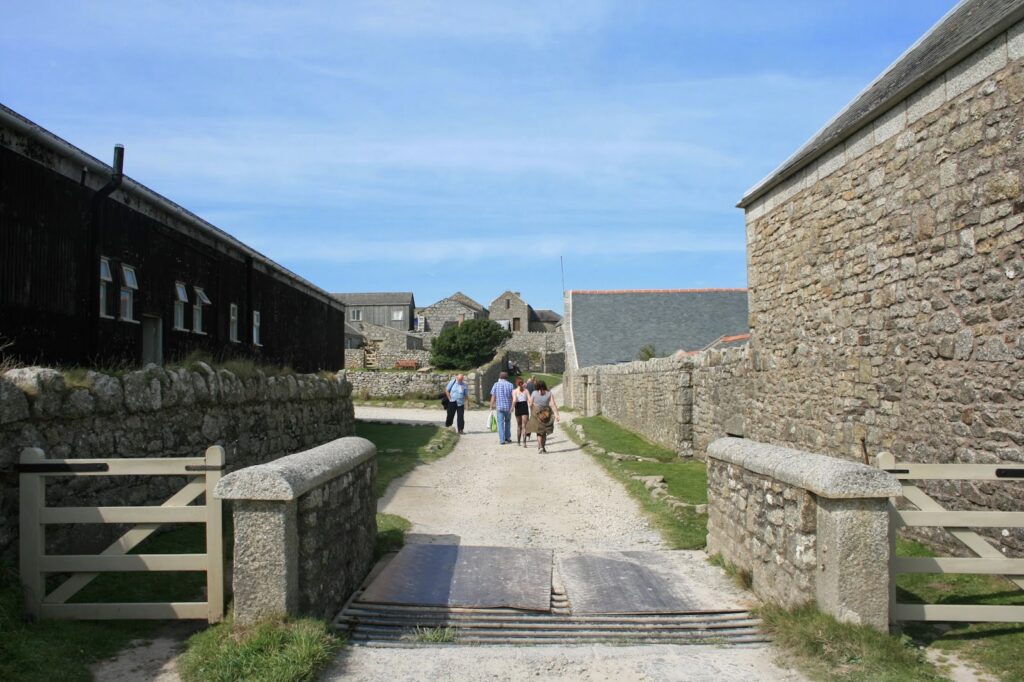
Lundy Road You can see how these buildings were once farm houses. We even saw a 4×4 turned fire rescue truck in one of the garages; Being such a small island community is irrelevant when the possibility of danger is always present.
Further down the way we saw people gathering outside a building which we soon discovered was the Marisco Tavern, Lundy’s one and only pub! Given how hot it was outside and the walk up, it made sense to want a refreshment here.

Marisco Tavern The Marisco Tavern. Lundy’s one and only pub.
Just around the corner from the Marisco we walked past what looked like a boat grave yard with bits and pieces of propellers, anchors and other items from ships which probably came into difficulties on and around Lundy’s coast.
Unfortunately from the time of landing at Lundy we were only given three hours on the island before the boat departed. Three hours isn’t really enough time to explore much on the island. By this time we had walked to the Marisco Tavern we had been on the island almost one and half hours. Usually we like to feel accomplished in seeing as much as we can in the time we have so we decided to walk as much of the length of the island as we could, turn round and walk along the coastal path.
Visitors to Lundy are given a folded leaflet containing information and a map of the island; We used this map to identify where we could walk to before heading back. Reading the map, we could see three lines running across the width of the island, spaced out along the islands length in quarter, half and three quarter points. These lines were walls; I wouldn’t like to say but the purpose of these walls might have been to help people like us; That, or it was intended to be a measurement for land owners/farmers. I assume the later.
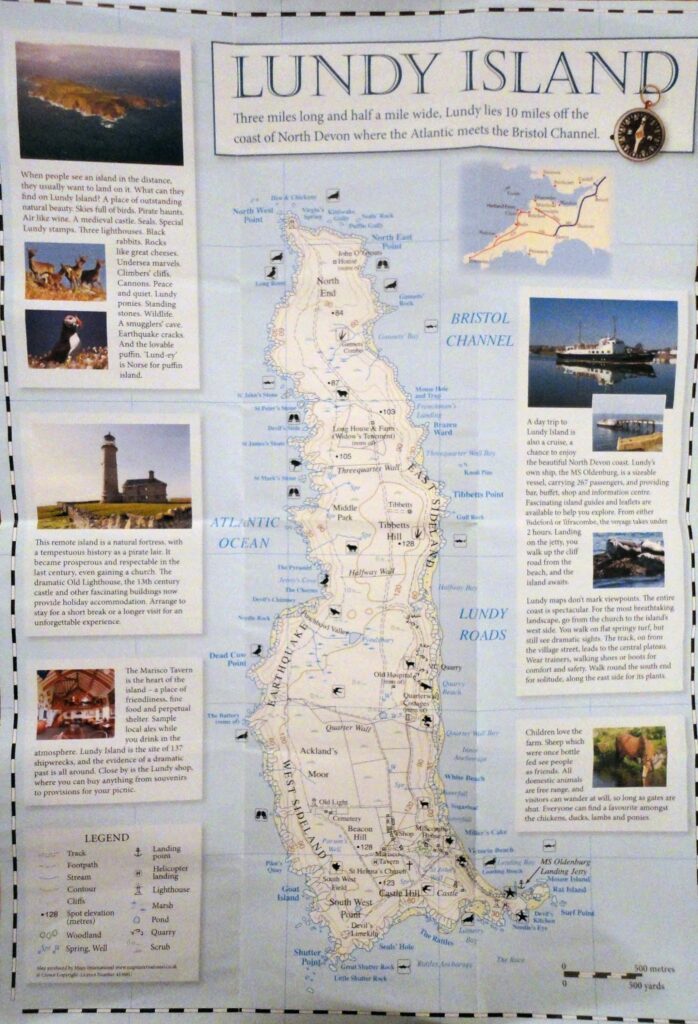
Map of Lundy Walking the spine of the island, you get a real sense of remoteness. You are surrounded by fields. The further you walk away from the main part of the village the more daring it gets as phone signal is poor/non-existent here; For us, it’s all part of the adventure.
We approached the halfway wall and decided to head back towards the harbour, this time walking along the coastal path. We thought the main walking route was remote but the coastal path put us in even more solitude. I must say though, it was a good choice because the views out to sea and along the islands cliffs were a pleasure to see.
While the plateau of the island is more exposed, the coastal path is more sheltered. There are more plants and wildlife around here, the scrubs and overgrowth provide a green wash of colour all over the cliff side with the blue of the sea jutting out from underneath.
Time was against us walking back but that did not stop us from appreciating the scenery. As we gained closer to the harbour the path became more accessible. We saw wild deer running down the hillside, probably spooked by our presence.

Heligoland Trap A Heligoland trap took our interest as we walked past. These are large, funnel shaped traps usually made from wire mesh or netting. Their purpose is to capture birds so they can be tagged or studied by ornithologists. Given the amount and rarity of birds that have been known to visit the island it would make sense to study them here.

Lundy Island Coastal Path Walking back to the harbour along the coastal path. We saw some great views.
As we walked closer to the harbour we could see more and more people flocking in the same direction. You could have mistaken it as a scene from a zombie movie! We got to the boat in time and sailed off towards Ilfracombe. The sun was setting on the day which made for a relaxing trip back. We arrived in Swansea around about half nine by which at this time the sun had fully set into dusk and everyone was looking forward to getting home after a long and exhausting day out.
After wondering about this mystic island for all those years I can finally say I’ve seen it in person. What an amazing place. It may be a small island and you won’t find big hotel chains or busy night-life; that’s what makes it good. It’s full of natural beauty and a solitude that you will be hard pressed to find elsewhere around the UK.
You can visit Lundy by boat from Ilfracombe, Bideford or Swansea. I believe there are also helicopter flights which are much quicker. Personally I enjoy the boat. If you wanted to stay on the island that is also possible as there are multiple accommodations including Millcombe House, the building I found so exquisite.
Hopefully one day I will be back again, perhaps to stay a bit longer and explore more of the island. In the mean time I will keep the memories and glance over at the island in the distance.